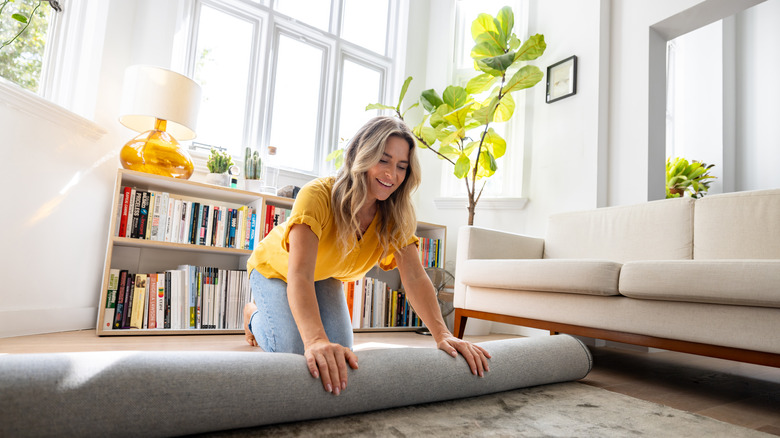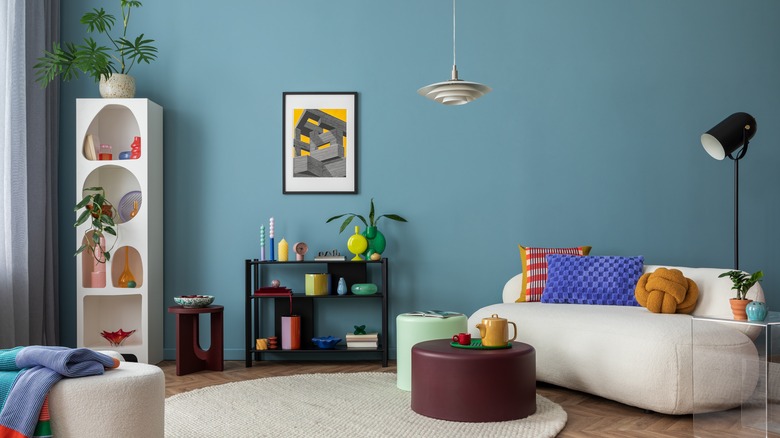Eclectic Minimalism Is The Trend That Brings Together The Best Of Both Worlds
As the saying goes, "New year, new you" — and that may mean revamping your living space to create a haven of joy and inspiration. If you're not afraid of mismatching when it comes to interior design but don't want your house to look as if a thrift store exploded in it, eclectic minimalism may be for you. This design trend combines eclecticism — a seemingly limitless incorporation of multiple styles, ages, colors, and textures— and minimalism, a style that gives your space breathing room with neutral color palettes, sparse furniture and decorations, and simple lines.
We're seeing characteristics of this blended style in an eclectic living room trend that creates a relaxed look in your home and in furniture choices with this minimalist trend that is dominating home materials in 2025. In an exclusive interview with House Digest, Erika Dale, interior designer and founder of Erika Dale Interior Design, said that eclectic minimalism is "for those who appreciate the relief of negative space and intentionality of décor associated with minimalism but prefer to take the color, personality, and quirkiness a step further than the typical monochromatic minimalist interior by featuring unique silhouettes, artwork, color, texture, and pattern." In essence, this trend allows you to find and use specific pieces that are unapologetically you.
Designing with an eclectic minimalist style
"The key to pulling off this aesthetic is to feature a mix of furniture from different styles and eclectic décor items, such as charming vintage treasures or rugs, personal collections, unique artwork, and textiles with some unexpected variation in color and pattern," explains Erika Dale exclusively to House Digest. She also cautions to "treat the items with the same intentionality as a minimalist, allowing each piece to shine with plenty of adjacent negative space." This differentiates eclectic minimalism from eclectic maximalism, which overwhelms the space with personality and visual stimulation.
At the same time, be mindful of what everyone gets wrong about minimalist interior design and décor. Minimalism doesn't mean sterile, dull, and lifeless. In their Instagram post, Australian furniture company Esho Gallery states that the "style is for those who appreciate diversity and uniqueness, but strive for order and simplicity in their interior design." The post showcases pairings of furniture styles, colors, and textures that add contrast and interest to living spaces. For example, they combine a modern sofa with a vintage armchair and a mid-century style table, as well as simple contemporary lights mixed with those from other eras.
Don't be afraid of color
Minimalism is also associated with neutral tones — black, white, gray, and beige — which we still see in the eclectic minimalist style. However, in her exclusive interview with House Digest, Erika Dale encourages people to take risks with their palette. "You can still achieve the clean airiness of minimalism while featuring hues other than white, beige, and brown. It is the negative space that gives minimalism its openness, not simply a lack of color," she says.
One way to achieve this is to start with furniture that reflects natural materials characteristic of minimalism, such as wood, stone, glass, and metal. Then, incorporate eclectic statement pieces reflective of your personal style — vibrant beaded pillows from recent travels, a simple thrifted vase, or a bright woven planter — being intentional about the textures and patterns you choose. Overall, Dale says, "Have some fun, and let those eclectic items bring in some charm, character, and color."

